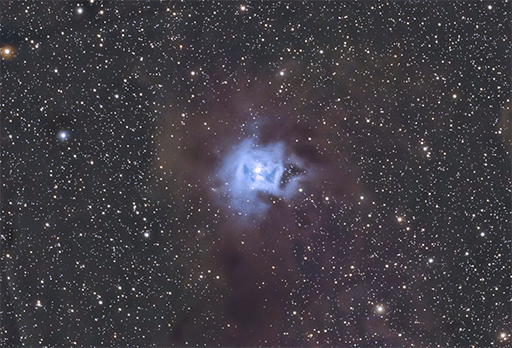The Iris Nebula (NGC 7023) is a reflection nebula in Cepheus. The bright blue star (SAO 19158) at the centre of this photograph is illuminating the surrounding interstellar dust cloud and so it appears blue. The dust also preferentially reflects blue light because of scattering and its wavelength. Most of the rest of the dust cloud has a brown tint due to photoluminescence.
This photo clearly reveals the dark brown dust cloud in the foreground in addition to other details. This was possible because my sensitive astro camera combined with the 9 h 29 min total exposure allowed me to carefully separate out the very dark foreground dust clouds from the very dark background. I last photographed this target on 22 April 2020, and this level of detail was not possible after just the 4 h 28 min I gathered then. The background and dust just appeared together as homogeneous grey! This year, however, I gathered another 5 h 1 min and stacked both data sets together for a better signal-to-noise ratio.
Unfortunately, as can be seen from the image below, I did not have exactly the same camera orientation, and this resulted in seams and mismatched background brightness in the corners after stacking. I initially tried to fix this using Gradient XTerminator but the gradient was too severe for it. So in the end I used a technique that many would frown on… I removed the stars with StarNet, selected the affected corners in Photoshop, replaced the selected areas using Content Aware Fill, and then re-added the stars using the Screen blending mode before continuing the processing. It worked very well from an aesthetics point of view, but the background of the very corner regions (not the stars, they are fine) are now not accurate representations of reality. I preferred this, however, to the alternative of cropping down the image.

Frames
- 9 h 29 min total exposure time
- On 21 April 2021: 301× 60-s light frames (Gain 900)
- On 20 April 2020: 134× 180-s light frames (Gain 900)
- Full use of calibration frames from each date (darks, flats and dark flats)
Equipment
- Explore Scientific ED 102 mm Apo f/7 refractor
- Sky-Watcher EQ6-R PRO SynScan GOTO equatorial mount
- Altair Hypercam 294C PRO colour fan-cooled camera
- Revelation Adjustable Field Flattener
- Altair 60mm guide scope
- Altair GPCAM2 AR0130 mono guide camera
Software
- Sharpcap
- PHD2
- DeepSkyStacker
- Photoshop
- StarNet
- Topaz Labs DeNoise AI
- Gradient XTerminator


